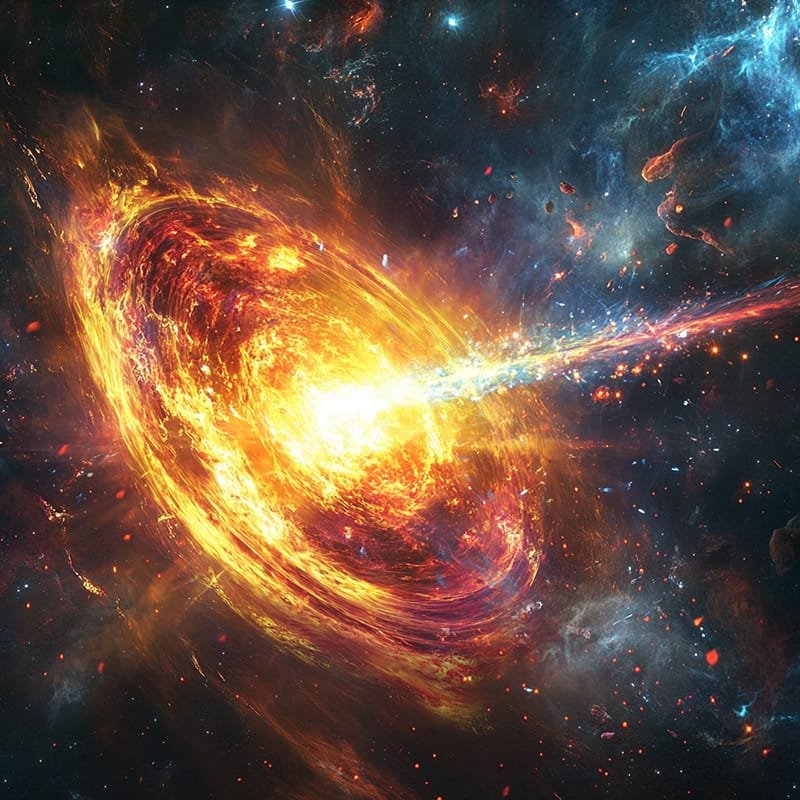Discover when the universe will end! Explore theories like the Big Freeze and Big Rip. Unravel cosmic mysteries today!
When Will the Universe End? Current Scientific Understanding
Key Takeaways
- Scientists have proposed five main scenarios for the universe‘s end: the Big Freeze, the Big Rip, the Big Crunch, the Big Bounce, and Vacuum Decay.
- The Big Freeze is the most widely accepted theory, suggesting the universe will expand forever and reach a state of maximum entropy.
- Dark energy, a mysterious force driving the universe’s accelerated expansion, plays a key role in determining the universe’s fate.
- The timeline for these scenarios ranges from billions to trillions of years, with some processes taking incomprehensibly long periods like 10^100 years.
- Ongoing research, such as the Dark Energy Spectroscopic Instrument (DESI) and particle physics experiments, continues to refine our understanding of the universe’s future.
The question of “When will the universe end?” is one of the most profound mysteries in science. For centuries, humans have gazed at the night sky wondering about the ultimate fate of the cosmos. Will it keep expanding forever? Will it collapse into itself? Or will some unforeseen quantum event bring about its abrupt destruction?Thanks to advancements in cosmology and physics, scientists have developed several theories about how the universe might end. These potential outcomes depend on factors like the universe’s rate of expansion, the properties of dark energy, and the role of dark matter. In this article, we’ll explore the leading scientific theories about the universe’s fate, the factors that influence these scenarios, and the ongoing research that aims to uncover the truth.
Main Scenarios for the End of the Universe
1. The Big Freeze (Heat Death)
The Big Freeze, also known as heat death, is the most widely supported theory among cosmologists. In this scenario, the universe continues expanding forever, but as it does, it becomes colder, darker, and less active.
How It Works:
- The universe’s expansion causes galaxies to move farther apart, reducing interactions between them.
- Stars slowly burn out, leaving behind cold remnants like white dwarfs, neutron stars, and black holes.
- Over time, the universe cools, approaching absolute zero temperature.
- Energy becomes evenly distributed, meaning no usable energy remains to sustain processes like star formation, life, or motion.
Eventually, the universe reaches a state of maximum entropy, where all matter and energy are uniformly spread out, and no more work can be done. This is the ultimate state of thermodynamic equilibrium.
Timeline:
The Big Freeze would take an almost incomprehensible amount of time. Scientists estimate the process could take 10^100 years or more (that’s a number with 100 zeros!). This timeline aligns with current observations of the universe’s accelerating expansion, driven by dark energy.
2. The Big Rip
The Big Rip is a far more violent and catastrophic scenario than the Big Freeze. It hinges on the idea that dark energy, the mysterious force accelerating the universe’s expansion, could grow stronger over time.
How It Works:
- As dark energy becomes more dominant, the universe’s expansion accelerates to extreme levels.
- This acceleration overpowers the gravitational forces holding galaxies, stars, and planets together.
- Eventually, even atomic structures are torn apart, leading to the complete disintegration of all matter.
Timeline:
If the Big Rip occurs, it could happen in about 22 billion years, depending on how dark energy evolves. This scenario assumes that dark energy becomes increasingly dominant over time, which is still uncertain.
3. The Big Crunch
The Big Crunch is essentially the opposite of the Big Freeze. Instead of expanding forever, the universe’s expansion slows, stops, and reverses. Gravity then causes the universe to collapse in on itself.
How It Works:
- If the universe’s density is high enough, gravitational forces could eventually overcome expansion.
- The universe contracts, with galaxies, stars, and matter being pulled closer together.
- All matter collapses into a hot, dense state, similar to the conditions of the Big Bang.
This scenario suggests that the universe could end in a fiery, dense singularity—a sort of reverse Big Bang.
Timeline:
The timeline for the Big Crunch is uncertain, but it would occur over billions of years. However, current evidence—such as the accelerating expansion of the universe—makes this scenario less likely.
4. The Big Bounce
The Big Bounce builds on the Big Crunch scenario but adds a cyclical twist. After the universe collapses in a Big Crunch, it could “bounce” back and expand again, creating a new universe.
How It Works:
- The universe alternates between phases of expansion (Big Bang) and contraction (Big Crunch).
- Each cycle begins with a Big Bang and ends with a Big Crunch, potentially creating an eternal, cyclical universe.
This theory implies that the universe has no definitive beginning or end, and that our current universe might be just one in an infinite series of cycles.
5. Vacuum Decay (The Big Slurp)
The Vacuum Decay scenario, also known as the Big Slurp, is the most speculative and least comforting theory. It suggests that a quantum event could abruptly destroy the universe.
How It Works:
- The universe might exist in a “false vacuum” state, which is not its most stable energy configuration.
- If a bubble of “true vacuum” forms, it could expand at the speed of light, altering the laws of physics and destroying everything in its path.
Timeline:
The timeline for vacuum decay is unpredictable. It could happen billions of years from now—or it could occur tomorrow (though the probability is extremely low). This scenario is based on the principles of quantum mechanics.
Factors Influencing the Universe’s Fate
 galaxy with numerous stars, planets, and cosmic formations against a deep space background.” class=”wp-image-19455″/>
galaxy with numerous stars, planets, and cosmic formations against a deep space background.” class=”wp-image-19455″/>Several factors play a critical role in determining which of these scenarios is most likely:
1. Dark Energy
Dark energy accounts for about 68% to 72% of the universe’s total energy and matter. It drives the universe’s accelerated expansion, making it a key player in scenarios like the Big Freeze and Big Rip. Its nature remains mysterious, but scientists are studying whether it is constant, weakening, or strengthening over time.
2. The Universe’s Expansion Rate
The universe’s expansion rate, measured by the Hubble constant, is critical. Current observations suggest the universe’s expansion is accelerating, favoring the Big Freeze or Big Rip. However, ongoing discrepancies in measuring the Hubble constant (known as the Hubble tension) could indicate gaps in our understanding of cosmic expansion.
3. Dark Matter
Dark matter, which makes up about 27% of the universe, plays a role in holding galaxies together with its gravitational effects. While not as influential as dark energy for the universe’s fate, its interactions with other forces could shape cosmic evolution.
4. Shape and Density of the Universe
The universe’s shape—flat, open, or closed—affects its long-term trajectory. Current evidence suggests the universe is flat, which aligns with the Big Freeze scenario.
Recent Advancements in Cosmology
Ongoing research is helping scientists refine their understanding of the universe’s fate:
- DESI (Dark Energy Spectroscopic Instrument):
- DESI has created the most detailed 3D map of the universe to date, allowing scientists to study the history of cosmic expansion.
- Holographic Dark Energy:
- A novel theory suggests the universe might be a two-dimensional structure with quantum forces giving the illusion of three-dimensional space. This could lead to a “long freeze,” where expansion slows and halts.
- Particle Physics:
- Experiments at facilities like CERN aim to study particles like the Higgs boson, which could provide insights into dark energy and quantum mechanics.
When Will the Universe End?

The universe’s end is a distant yet fascinating mystery. While the exact answer remains uncertain, current evidence suggests that the Big Freeze is the most likely outcome, where the universe cools and expands indefinitely. Other scenarios like the Big Rip, Big Crunch, or Vacuum Decay remain theoretical possibilities, depending on the evolution of dark energy and cosmic forces.These predictions remind us of the vastness of time and space—and how much there is still to learn about the cosmos. As research advances, we may uncover new insights that reshape our understanding of the universe’s ultimate fate.For now, the end of the universe remains an open question—but one that continues to inspire awe and curiosity.
Sources:
- NASA: Dark Energy and the Accelerating Universe
- Harvard-Smithsonian Center for Astrophysics: Universe’s Fate
- Scientific American: The Hubble Tension
 space background.” class=”wp-image-19455″/>
space background.” class=”wp-image-19455″/>





























